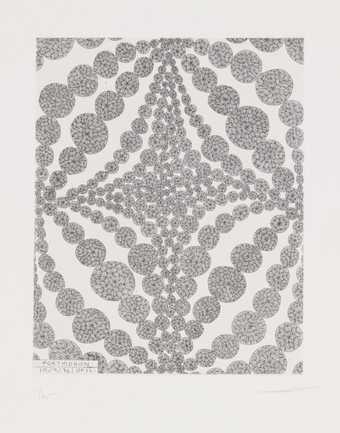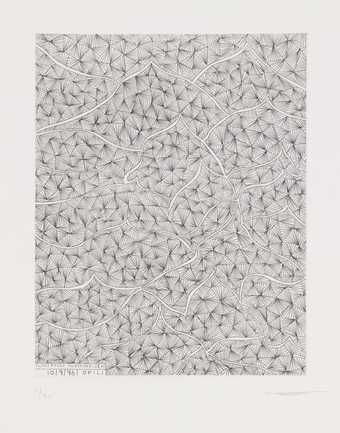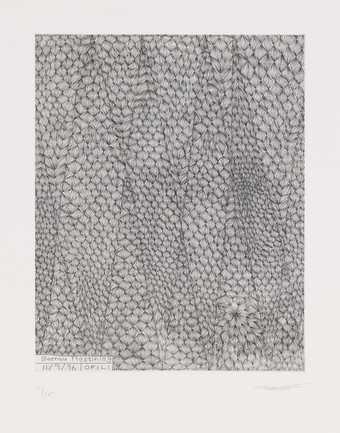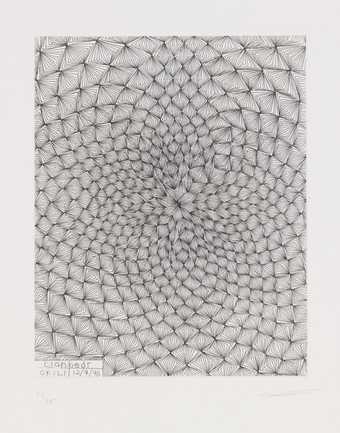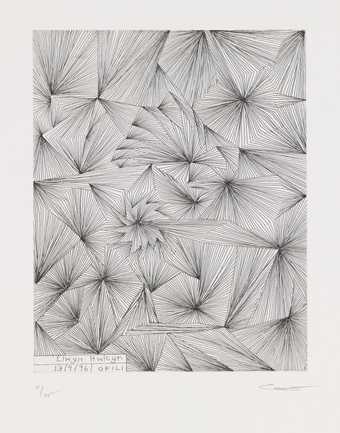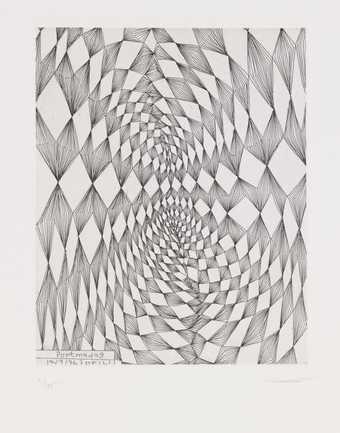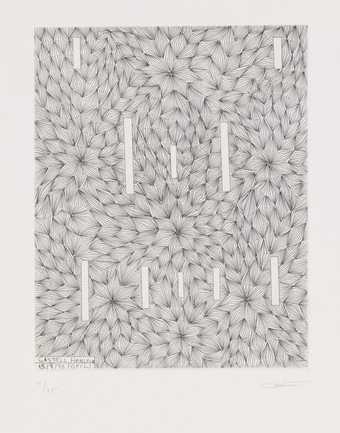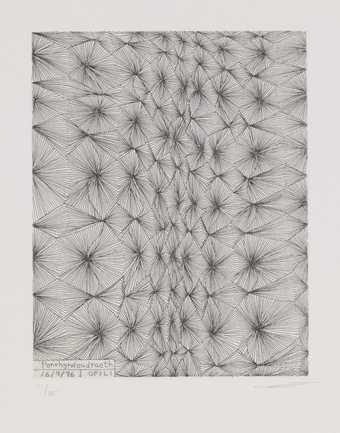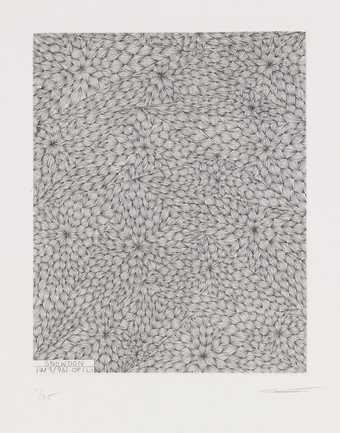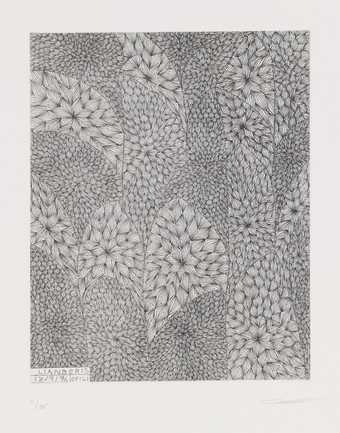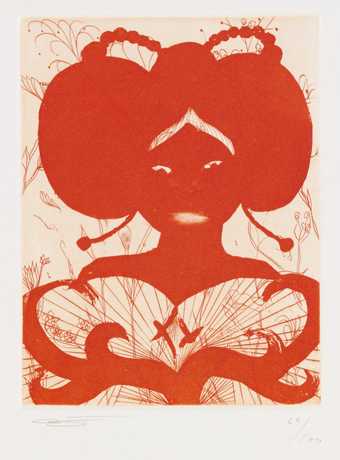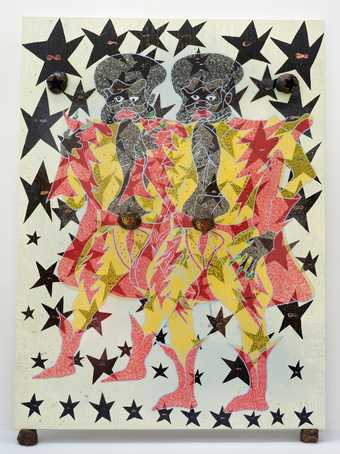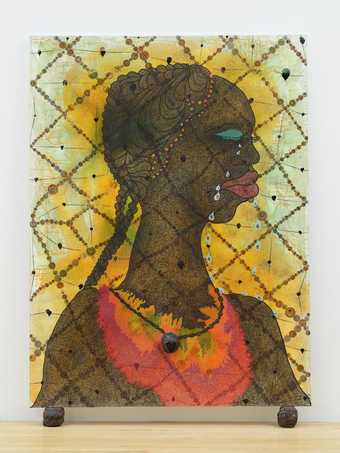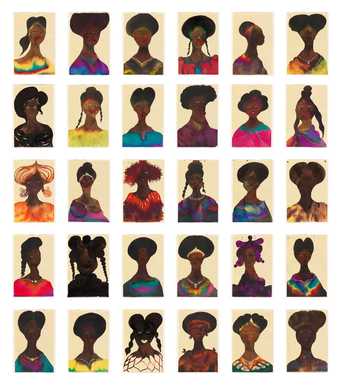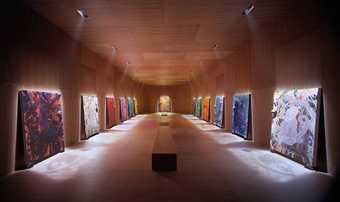
Not on display
- Artist
- Chris Ofili CBE born 1968
- Medium
- Graphite on paper
- Dimensions
- Support: 565 × 760 mm
- Collection
- Tate
- Acquisition
- Presented by Victoria Miro Gallery 2000
- Reference
- T07662
Summary
While Chris Ofili is best known for his elaborate figurative paintings, he has consistently produced drawings, as well as prints and watercolours, as parallel activities to his painting practice. Ofili’s colouful paintings (such as No Woman No Cry 1998, Tate T07502) are typically glossy with layers of resin, and often embellished with glitter and collaged elements, including, notoriously, lumps of elephant dung (as in Double Captain Shit and the Legend of the Black Stars 1997, Tate T07345)). With his drawings, Ofili develops his decorative patois with far simpler tools. Often monochromatic, as in afro, his drawings rely on intricate and juxtaposed areas of patterning for their decorative effect.
This work is dominated by the single word ‘afro’, inscribed in lowercase cursive script. Closer inspection reveals that the letters are formed by a chain of tiny portraits. Each of these heads sports a distinctive afro hairstyle, defined by a dark smudge of soft pencil. Concentric circles loop out from each head forming an intricately detailed pattern.
The decorative aspects of his work are underpinned by wit and an engagement with issues of racial prejudice and cultural stereotypes. The afro is a motif Ofili uses as an ironic symbol of power and pride. The simple portraits that make up the word ‘afro’ are all subtly different, but Ofili’s use of them as a repeated decorative element or pattern plays on the cliché that all black (or other ethnic) people look alike to someone outside their racial group.
Further reading:
Chris Ofili, within reach, exhibition catalogue, British Pavilion, 50th Venice Biennale, Victoria Miro Gallery, London, 2003.
Chris Ofili, exhibition catalogue, Southampton City Art Gallery, 1998.
Laura Hoptman, Drawing now: eight propositions, exhibition catalogue, Museum of Modern Art, New York, 2002.
Maria Bilske
November 2004
Does this text contain inaccurate information or language that you feel we should improve or change? We would like to hear from you.
Display caption
The composition of this drawing is dominated by the word ‘afro’, and the flowing lines which emanate from it. Closer examination reveals that the word is composed of tiny drawings of heads. Ofili revels in such visual puns. Underlying this work is Ofili’s response to the racist view that ‘all black people look the same’. The afro becomes a statement of black pride and, since each tiny head is different, a way to create individual portraits.
Gallery label, September 2004
Does this text contain inaccurate information or language that you feel we should improve or change? We would like to hear from you.
Explore
- abstraction(8,615)
-
- non-representational(6,161)
-
- text(1,043)
- social comment(6,584)
-
- race(381)
You might like
-
Chris Ofili CBE Portmerion 10.9.96
1996 -
Chris Ofili CBE Twynitywod Morfa Harlech 10.9.96
1996 -
Chris Ofili CBE Blaenau Ffestiniog 11.9.96
1996 -
Chris Ofili CBE Llanbedr 12.9.96
1996 -
Chris Ofili CBE Llwyn Hwlcyn 13.9.96
1996 -
Chris Ofili CBE Portmadog 14.9.96
1996 -
Chris Ofili CBE Castell Harlech 15.9.96
1996 -
Chris Ofili CBE Penrhyndeudraeth 16.9.96
1996 -
Chris Ofili CBE Snowdon 17.9.96
1996 -
Chris Ofili CBE Llanberis 17.9.96
1996 -
Chris Ofili CBE [no title]
1999–2000 -
Chris Ofili CBE Double Captain Shit and the Legend of the Black Stars
1997 -
Chris Ofili CBE No Woman, No Cry
1998 -
Chris Ofili CBE Untitled
1998 -
Chris Ofili CBE The Upper Room
1999–2002

